筛选苗期耐低氮的主要高粱种质,并从碳氮代谢中进行鉴定
IF 4.1
2区 生物学
Q1 PLANT SCIENCES
引用次数: 0
摘要
引言 高粱(Sorghum bicolor L.)能够承受干旱和高温胁迫,并能有效利用水分和养分。材料与方法 本研究评估了 100 个高粱育种品系对低氮胁迫的耐受性,并鉴定出具有特殊抗逆性的品系。研究采用主成分分析法、皮尔逊相关分析法和Y值分析法来考察各种幼苗生长指标,包括植株和根系尺寸、生物量、叶绿素含量、根氮含量、芽氮含量和根/芽比。耐低氮高粱品系保持了较高的光合速率,叶片和根系中与碳和氮代谢相关的酶活性也有所提高。此外,耐低氮基因型的胱氨酸、甘氨酸、组氨酸、异亮氨酸、亮氨酸、苯丙氨酸、苏氨酸和酪氨酸等关键氨基酸的含量较高,表明其内部代谢对氮缺乏的反应较强。本文章由计算机程序翻译,如有差异,请以英文原文为准。
Screening key sorghum germplasms for low-nitrogen tolerance at the seedling stage and identifying from the carbon and nitrogen metabolism
IntroductionSorghum (Sorghum bicolor L.) can withstand drought and heat stress and efficiently utilize water and nutrients. However, the underlying mechanism of its tolerance to low-nitrogen (N) stress remains poorly understood.Materials and methodsThis study assessed low-N tolerance in 100 sorghum-inbred lines and identified those with exceptional resilience. Principal component analysis, Pearson’s correlation, and Y value analysis were used to examine various seedling growth metrics, including plant and root dimensions, biomass, chlorophyll content, root N content, shoot N content, and root/shoot ratio.Results and discussionThe genotypes were categorized into four distinct groups based on their respective Y values, revealing a spectrum from highly tolerant to sensitive. Low-N-tolerant sorghum lines maintained higher photosynthetic rates and exhibited increased enzymatic activities linked to carbon and N metabolism in the leaves and roots. Furthermore, low-N-tolerant genotypes had higher levels of key amino acids, including cystine, glycine, histidine, isoleucine, leucine, phenylalanine, threonine, and tyrosine, indicating a robust internal metabolic response to N deficiency.ConclusionThis study provides a comprehensive and reliable approach for the evaluation of sorghum tolerance to low-N environments, sheds light on its morphological and physiological adaptations, and provides valuable insights for future breeding programs and agricultural practices.
求助全文
通过发布文献求助,成功后即可免费获取论文全文。
去求助
来源期刊

Frontiers in Plant Science
PLANT SCIENCES-
CiteScore
7.30
自引率
14.30%
发文量
4844
审稿时长
14 weeks
期刊介绍:
In an ever changing world, plant science is of the utmost importance for securing the future well-being of humankind. Plants provide oxygen, food, feed, fibers, and building materials. In addition, they are a diverse source of industrial and pharmaceutical chemicals. Plants are centrally important to the health of ecosystems, and their understanding is critical for learning how to manage and maintain a sustainable biosphere. Plant science is extremely interdisciplinary, reaching from agricultural science to paleobotany, and molecular physiology to ecology. It uses the latest developments in computer science, optics, molecular biology and genomics to address challenges in model systems, agricultural crops, and ecosystems. Plant science research inquires into the form, function, development, diversity, reproduction, evolution and uses of both higher and lower plants and their interactions with other organisms throughout the biosphere. Frontiers in Plant Science welcomes outstanding contributions in any field of plant science from basic to applied research, from organismal to molecular studies, from single plant analysis to studies of populations and whole ecosystems, and from molecular to biophysical to computational approaches.
Frontiers in Plant Science publishes articles on the most outstanding discoveries across a wide research spectrum of Plant Science. The mission of Frontiers in Plant Science is to bring all relevant Plant Science areas together on a single platform.
 求助内容:
求助内容: 应助结果提醒方式:
应助结果提醒方式:


